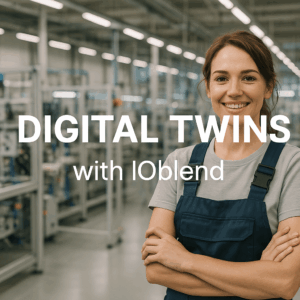Change Data Capture
In the fast-paced world of data management, staying ahead of the curve is not an option, it’s a necessity. Change Data Capture (CDC) is the secret weapon that allows businesses to keep pace with the constant flux of data.
In this blog, we will delve into the world of CDC, explore different approaches to implementing it, provide real-world examples, and understand why CDC is pivotal for modern data management. Furthermore, we will unveil how IOblend automates this crucial process, making it effortless and efficient for organizations.
Understanding Change Data Capture (CDC)
Change Data Capture is the technique of identifying and capturing changes in a database or data source. It allows organizations to track every modification, whether it’s a new record, an update, or a deletion, and transform these changes into a digestible format. CDC ensures that decision-makers have access to the most recent and accurate data, enabling data-driven decisions in real-time.
Various Approaches to Implement CDC
There are several approaches to implementing CDC, each suited for different use cases and infrastructures:
Trigger-Based CDC: This method uses database triggers to capture changes as they occur. When an event (insert, update, delete) happens, the trigger captures and logs the change.
Log-Based CDC: In this approach, CDC relies on the transaction logs of the source database. It reads the log files and identifies changes, making it highly efficient and minimally intrusive.
Query-Based CDC: Query-based CDC periodically scans the source database to identify changes. It’s a flexible approach but can be resource intensive if not optimised for performance.
Hybrid CDC: Combining elements of the above approaches, hybrid CDC offers a balanced solution tailored to specific use cases.
Examples of CDC in Action
E-commerce Inventory Management: Imagine an e-commerce platform that needs to keep track of product availability. With CDC, any change in inventory, such as a new product being added or an existing one going out of stock, is instantly captured. This ensures that customers see up-to-the-minute product availability.
Financial Services: In the finance sector, stock market data changes in real-time. CDC helps financial institutions capture and analyse these changes instantly, allowing traders to make informed decisions on the spot.
Healthcare: CDC plays a crucial role in healthcare, where patient records are continuously updated. Medical professionals can promptly access the latest patient data, such as test results and treatment history.
Why CDC is Essential for Data Management
Change Data Capture is a crucial component of modern architectures and offers several key advantages for data management:
Real-time Decision-Making: CDC provides access to the most current data, enabling organizations to make real-time decisions, which is critical in fast-moving industries.
Data Accuracy: By capturing changes as they occur, CDC reduces the risk of data inconsistencies and inaccuracies.
Efficiency: CDC minimizes the need for resource-intensive batch processing, significantly reducing processing times.
Compliance: In regulated industries like finance and healthcare, CDC ensures data compliance by capturing every change made to sensitive information.
CDC allows transactional data to be available in real-time, without putting stress on the source systems. CDC does not require changes in the source application and reduces the transferred amount of data to a minimum, enhancing data management efficiency.
Change data capture makes it possible to replicate data from source applications to any destination without the burden of extracting or replicating entire datasets.
IOblend: Automating Change Data Capture
IOblend is an end-to-end enterprise data integration solution that incorporates all core DataOps capabilities. Here’s how IOblend streamlines CDC:
Automated Hybrid CDC: IOblend automatically captures changes in your data sources, eliminating the need for manual monitoring. If your system supports log-based CDC, IOblend will track all changes (inserts, updates and deletes) and materialise the full history and/or the latest updates as required. If you are using trigger-based CDC, we will query against the triggers. Finally, we use a highly optimised query-based CDC, a proprietary algorithm to scan for changes between “created” and “modified” dates for each record on reads, placing only minimal stress on the source systems/databases. All three methods require no coding. We give you the full flexibility to deploy any type of CDC that suits your architecture.
Seamless Integration: Perform CDC on any source, perform in-memory transformations, and sink the results to any destination with minimal effort. We combine CDC with advanced ETL capabilities to greatly enrich your data management capabilities without the requirement to code.
No Need for Staging: IOblend’s in-flight ETL capability reduces processing times by performing transformations on the new and updated data without the need for staging. Your data never leaves your security umbrella unlike with most SAAS solutions.
Full DataOps: IOblend covers the entire data journey, from record-level lineage tracking to metadata management, schema evolution, event handling, and much more.
Change Data Capture is a game-changer in the world of data management, and IOblend takes it to the next level with its automation capabilities. With IOblend, you can effortlessly capture changes in your data, reduce processing times, ensure data accuracy, and empower your organization with real-time insights. There is no need to use any additional tools or third-party modules with IOblend – we provide the full “end-to-end” data integration capability out of the box. Embrace the power of CDC with IOblend and stay ahead in the data-driven race.
Download your FREE Developer Edition now and experience the future of data management.
Managing Change Data Capture (CDC) effectively, a crucial component in modern data management, is simplified by IOblend’s automated approach. CDC, the process of identifying and capturing changes in databases or data sources, is pivotal for enabling real-time, data-driven decision-making. IOblend streamlines this with various CDC methods such as trigger-based, log-based, and query-based, suited for different use cases. This automated hybrid CDC ensures real-time data availability, accuracy, and minimizes the need for resource-intensive batch processing. IOblend’s capabilities also extend to seamless integration, in-flight ETL without staging, and full DataOps coverage, including record-level lineage tracking and metadata management. This comprehensive approach makes CDC an efficient and effortless process, allowing businesses to stay agile and informed with up-to-date data insights.

ERP Cloud Migration With Live Data Sync
Seamless Core System Migration: The Move of Large-Scale Banking and Insurance ERP Data to a Modern Cloud Architecture ⛅ Did you know that core system migrations in large financial institutions, which typically rely on manual data mapping and validation, often require parallel runs lasting over 18 months? The Core Challenge The migration of multi-terabyte ERP and

Legacy ERP Integration to Modern Data Fabric
Warehouse Automation Efficiency: Migrating and Integrating Legacy ERP Data into a Modern Big Data Ecosystem 📦 Did you know? Analysts estimate that warehouses leveraging robust, real-time data integration see inventory accuracy improvements of up to 99%. The Convergence of WMS and Big Data Data professionals in logistics face a profound challenge extracting mission-critical operational data such

Dynamic Pricing with Agentic AI
The Agentic Edge: Real-Time Dynamic Pricing through AI-Driven Cloud Data Integration 📊 Did You Know? The most sophisticated dynamic pricing systems can process and react to market signals in under 100 milliseconds. The Evolution of Value Optimisation Dynamic Pricing and Revenue Management (DPRM) is a complex computational science. At its core, DPRM aims to sell the right

Smarter Quality Control with Cloud + IOblend
Quality Control Reimagined: Cloud, the Fusion of Legacy Data and Vision AI 🏭 Did You Know? Over 80% of manufacturing and quality data is considered ‘dark’ inaccessible or siloed within legacy on-premises systems, dramatically hindering the deployment of real-time, predictive Quality Control (QC) systems like Vision AI. Quality Control Reimagined The core concept of modern quality

Predictive Aircraft Maintenance with Agentic AI
Predictive Aircraft Maintenance: Consolidating Data from Engine Sensors and MRO Systems 🛫 Did you know that leveraging Big Data analytics for predictive aircraft maintenance can reduce unscheduled aircraft downtime by up to 30% Predictive Maintenance: The Core Concept Predictive Maintenance (PdM) in aviation is the strategic shift from a time-based or reactive approach to an ‘as-needed’ model,

Digital Twin Evolution: Big Data & AI with
The Industrial Renaissance: How Agentic AI and Big Data Power the Self-Optimising Digital Twin 🏭 Did You Know? A fully realised industrial Digital Twin, underpinned by real-time data, has been proven to reduce unplanned production downtime by up to 20%. The Digital Twin Evolution The Digital Twin is a sophisticated, living, virtual counterpart of a physical production system. It

